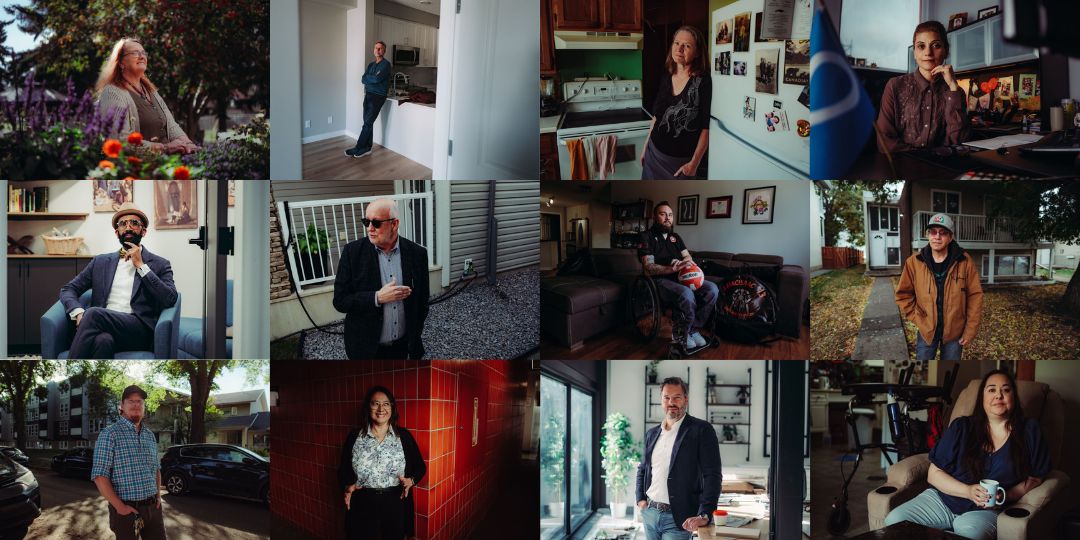A man whose life veered toward homelessness after injuring his leg. A real estate agent who's convinced owning a home may not be for everyone. A senior forced to survive on garage sale proceeds. A developer working to make multi-family housing as appealing as the single-family home. A manager straddling the fence between landlords and housing-first tenants. An advocate who uses her painful experiences to help those confronting homelessness. A property manager handing out rent increases of no less than $100 a month. A landlord forced to remain one after buying at the height of the 2008 boom and never being able to sell without a loss. A wheelchair user who feels forgotten by housing design and maintenance practices.
These are a few of the glimpses into the lives of people in various roles within Edmonton's housing ecosystem gathered for a project we're calling Housing Complex. Like all ecosystems, each of the positions these people occupy is interrelated. Some win. Many feel conflicted, or like they're treading water. Some lose in awful ways. But to change Edmonton's housing ecosystem to ensure fewer people lose will mean affecting all involved — whether by forcing them to accept density in their backyards, slowing the speed at which their home grows in value, controlling rent increases, or investing public money to create more housing for people the system leaves out. That means changing anything related to housing is complex.
Edmonton is renowned in other Canadian cities for moving big rocks on the supply side of housing policy that others can't or won't. Experts say we're trailblazers on zoning reform, accelerating infill, ridding ourselves of parking minimums, and deregulating density. One need only look at Taproot's recent stories on backyard suite permits doubling in 2024, the city proactively upzoning land within the core, or proposals to develop agricultural land within city limits for evidence these reforms can create change.
And yet there is another Edmonton where people struggle to find the housing they need. It's a city where rents are increasing faster than some other major Canadian cities and outpacing how fast our incomes are growing, where vacancy rates are the lowest they've been in a decade, where newcomers are arriving in numbers we haven't seen in a generation, where Alberta's legacies as the site of the most residential schools in Canada echo throughout our community, where car-culture design continues to externalize costs onto individuals, where housing developments in our downtown are stalled despite population growth, where we see members of our community struggling in numbers and ways that are terrifying, and where an increasing number of us feel our relationship to housing is more precarious than ever. As the City of Edmonton often points out, one in eight households is in core housing need, which means one in eight of us live in housing that does not meet standards of adequacy, suitability, or affordability, where the household would have to spend 30% or more of its before-tax income to access local housing that meets all three standards.
Often, the difference between thriving and surviving in this ecosystem can be chalked up to income, with only those who make the least deemed to be struggling. Edmonton's average home price (across all housing types) is roughly $400,000, much lower than in Toronto and Vancouver, where the figure tops $1 million. Wages, meanwhile, are high here relative to other cities. Could Edmonton be the anomaly to escape a crisis that has otherwise swept across most of Canada? Or could it be could be "the next domino to fall," as Gregor Craigie, author of Our Crumbling Foundation, said during a recent chat on the housing crisis? Given how many people are moving here to escape the Toronto and Vancouver markets, the pressure on housing is only increasing.
Trying to make sense of this is daunting, but we're using two tools to increase your understanding. One is a series of portraits captured by writer Eric Rice and photographer Jordon Hon based on interviews with 12 people about their place in Edmonton's housing ecosystem. The idea behind that series of vignettes, pursued in collaboration with the Edmonton Coalition on Housing and Homelessness and funded by the Alberta Real Estate Foundation, was to surface real-life experiences with the way housing works (and doesn't) in Edmonton. These are but 12 stories among more than a million, but we hope it creates a bit of empathy and understanding across the board. (See editor-in-chief Karen Unland's post for more about why and how this series was created.)

Welcome to Housing Complex, Taproot's series on Edmonton's housing ecosystem. Many thanks to housing advocate Nadine Chalifoux for welcoming Eric Rice and Jordon Hon into her home, where this doormat greets visitors. (Jordon Hon)
Our second tool is more analytical. Taproot's reporting team is working to equip readers with facts to better understand what could, should, or should not change. We've spoken to experts to understand why Edmonton's system works the way it does. In a series of explainer articles we'll publish over the coming weeks, we will examine where Edmonton is at on housing supply, rents, government subsidies for housing, rental housing, infill, sprawl, and more, and what those experts suggest could and possibly should be done.
A difficult part of discussing Edmonton's housing system, though, is that it's not a formalized system at all. Instead, it's built on goodwill across different levels of government. "It relies on people being honest actors, and it doesn't have any kind of constitutional foundation to it," Damian Collins, the director of the Community Housing Canada Research Partnership at the University of Alberta, told Taproot. "And so, as we've seen recently, it doesn't take much for that partnership model to start to break down. As soon as one side starts putting their elbows out, then the partnership and the goodwill breaks down."
Governments hold most of the keys, but it's voters who hand those keys to the politicians they elect. Given this, Taproot sees one big citizen opportunity to act in October 2025, when we choose our next city council (and, let's not forget that we may also be sent back to the ballot box to elect our next federal government any time now, given Prime Minister Justin Trudeau's Liberals have a minority government and precarious support). The municipal election will send a message to our future council and to the provincial government, which won't have an election until 2027 (bar any government-defeating scandals), but will see the poll as a barometer of what matters to Edmonton.
Some will point out that our cities and their councils are creatures of the province, meaning they lack the constitutional authority or revenue sources to do much on housing. This is true, but only to a point, experts suggested to Taproot. Cities can always do something about housing, they said. So the questions you ask candidates at your door, the choices you make in the voting booth, and the priorities you convey to your municipality's council will have an effect. Our series aims to equip you to ask good questions, make informed decisions, and help effect the change you want if you see room for improvement.

Eric Rice interviewed a wide variety of people about their experiences with the housing system as the starting point of Housing Complex. (Jordon Hon)
The series and an event to discuss it
All of the vignettes collected by Rice and photographed by Hon are available now on the Housing Complex microsite site. All of the explainer articles and stories Taproot has written about housing in the past are findable there, too.
Here's the explainer work from the series so far:
-
Oct. 30: Would building more housing supply slow Edmonton's rising home prices? We explained that here.
-
Nov. 6: How should Edmonton grow to make our housing more attainable? We explained that here.
-
Nov. 13: What did the retreat from publicly funded housing do to housing in Edmonton? We explained that here.
-
Nov. 20: Does reaching 'peak home ownership' mean Edmonton should focus on rental housing? We explained that here.
There's still more to come Wednesday in The Pulse.
You're invited! On Nov. 27, come to CKUA to hear from people who brought the Housing Complex series to life, including Rice, Hon, and the Taproot team. Tickets are here. We'll invite you to share your curiosity about housing in Edmonton and hold a panel discussion that dives deep. Taproot Members receive a discount on the ticket price. Learn more about becoming a member.
Terminology
Taproot will not refer to "affordable housing" in this series. Some hear that as an expression of whether they personally can afford the housing they would like rather than the formal definition of housing that costs less than 30% of a household's before-tax income.
Instead, when we use terms they will be linked to specific definitions (drawn from the City of Edmonton's affordable housing strategy, Homeward Trust's glossary, and the Canada Mortgage and Housing Corporation's definitions):
-
Market housing: Housing priced at the level the market will bear.
-
Community or social housing: Housing developed with public funding and owned and or operated by government, a non-profit, or a co-operative.
-
Mixed-income housing:: Any type of housing development (rent or owned) that includes a range of income levels among its residents, including low, moderate, and/or higher incomes.
-
Emergency shelters: Short-term lodging for people experiencing homelessness.
-
Supportive housing: Facilities with integrated services to help people live independently.
-
Below-market housing: Private rental ownership units subsidized by government.
-
Private rental housing: Units owned by individuals or companies that charge market rents.
-
Core housing need: A household with housing that does not meet standards of adequacy, suitability, or affordability, where the household would have to spend 30% or more of its before-tax income to access local housing that meets all three standards.
What Taproot aims to achieve with this series is to resist over-simplification or suggest there are easy fixes. Housing seems like a wicked problem, and solving it is hard. But as Craigie pointed out during his visit to Edmonton to discuss his book at LitFest, we have to do something.
We hope you find our work meaningful and thought-provoking. And we hope you share your thoughts. If there are other stories we should look at, please reach out at hello@taprootedmonton.com.
